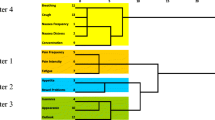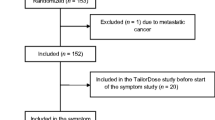Abstract
Purpose
To identify symptom clusters in advanced cancer patients attending a palliative radiotherapy clinic using the Edmonton Symptom Assessment System (ESAS).
Methods
Principal component analysis (PCA), exploratory factor analysis (EFA), and hierarchical cluster analysis (HCA) were used to identify symptom clusters among the nine ESAS items using scores from each patient’s first visit.
Results
ESAS scores from 182 patients were analyzed. The PCA identified three symptom clusters (cluster 1: depression-anxiety-well-being, cluster 2: pain-tiredness-drowsiness, cluster 3: nausea-dyspnea-loss of appetite). The EFA identified two clusters (cluster 1: tiredness-drowsiness-loss of appetite-well-being-pain-nausea-dyspnea, cluster 2: depression-anxiety). The HCA identified three clusters similar to the PCA with an exception of the loss of appetite item being classified under cluster 1 rather than 3. Two to three symptom clusters were identified using three analytical methods, with similar patterns reported in the literature. Particular groups of items co-occurred consistently across all three analyses: depression and anxiety; nausea and dyspnea; as well as pain, tiredness, and drowsiness.
Conclusion
Three similar symptom clusters were identified in our patient population using the PCA and HCA; whereas, the EFA produced two clusters: one physical and one psychological cluster. Given the implications of symptom clusters in the management of quality of life, clinicians should be aware of these clusters to aid in the palliative treatment of patients.

Similar content being viewed by others
References
Wentlandt K, Seccareccia D, Kevork N, Workentin K, Blacker S, Grossman D et al (2016) Quality of care and satisfaction with care on palliative care units. J Pain Symptom Manag 51(2):184–192
Gomez-Batiste X, Murray S, Thomas K, Blay C, Boyd K, Moine S et al (2017) Comprehensive and integrated palliative care for people with advanced chronic conditions: an update from several European initiatives and recommendations for policy. J Pain Symptom Manag. doi:10.1016/j.jpainsymman.2016.10.361
Chang VT, Hwang SS, Feuerman M, Kasimis BS (2000) Symptom and quality of life survey of medical oncology patients at a veteran affairs medical centre: a role for symptom assessment. Cancer 88:1175–1183
Portenoy RK, Thaler HT, Kornblith AB, Lepore JM, Friedlander-Klar H, Coyle N et al (1994) Symptom prevalence, characteristics and distress in a cancer population. Qual Life Res 3(3):183–189
Kim HJ, McGuire DB, Tulman L, Barsevick AM (2005) Symptom clusters: concept analysis and clinical implications for cancer nursing. Cancer Nurs 28:270–284
Teunissen SC, de Graeff A, de Haes H, Voest EE 2006 Prognostic significance of symptoms of hospitalized advanced cancer patients. Eur J Cancer 2510–16.
Fan G, Filipczak L, Chow E (2007) Symptom clusters in cancer patients: a review of literature. Curr Oncol 14(5):173–179
Fan G, Hadi S, Chow E (2007) Symptom clusters in patients with advanced-stage cancer referred for palliative radiation therapy in an outpatient setting. Support Cancer Ther 4(3):157–162
Chen E, Nguyen J, Khan L, Zhang L, Cramarossa G, Tsao M et al (2012) Symptom clusters in patients with advanced cancer: a reanalysis comparing different statistical methods. J Pain Symptom Manag 44(1):23–32
Bruera E, Kuehn N, Miller MJ, Selmser P, Macmillan K et al (1991) The Edmonton Symptom Assessment System (ESAS): a simple method for the assessment of palliative care patients. J Palliat Care 7(2):6–9
Chang VT, Hwang SS, Feuerman M (2000) Validation of the Edmonton Symptom Assessment Scale. Cancer 88:2164–2171
Moro C, Brunelli C, Miccinesi G, Fallai M, Morino P, Piazza M et al (2006) Edmonton Symptom Assessment Scale: Italian validation in two palliative care settings. Support Care Cancer 14(1):30–37
Skerman HM, Yates PM, Battistutta D (2009) Multivariate methods to identify cancer-related symptom clusters. Res Nurs Health 32:345–360
Barsevick AM, Whitmer K, Nail LM, Beck SL, Dudley WN (2006) Symptom cluster research: conceptual, design, measurement, and analysis issues. J Pain Symptom Manag 31:85–95
Kim HJ, Abraham IL (2008) Statistical approaches to modeling symptom clusters in cancer patients. Cancer Nurs 31:E1–10
Kirkova J, Walsh D, Aktas A, Davis MP (2010) Cancer symptom clusters: old concept but new data. Am J Hosp Palliat Care 27(4):282–288
Walsh D, Rybicki L (2006) Symptom clustering in advanced cancer. Support Care Cancer 14:831–836
Thavarajah N, Chen E, Zeng L, Bedard G, Di Giovanni J, Lemke M et al (2012) Symptom clusters in patients with metastatic cancer: a literature review. Expert Rev Pharmacoecon Outcomes Res 12(5):597–604
Mohamed S, Bagutavan S (2012) The effect of anxiety on breast cancer patients. Indian J Psychol Med 34(2):119–123
Burgess C, Cornelius V, Love S, Graham J, Richards M, Ramirez A (2005) Depression and anxiety in women with early breast cancer: five year observational cohort study. BMJ 330:702
Chow E, Fan G, Hadi S (2007) Symptom clusters in cancer patients with bone metastases. Support Care Cancer 15:1035–1043
Cheung WY, Le LW, Zimmermann C (2009) Symptom clusters in patients with advanced cancers. Support Care Cancer 17(9):1223–1230
Tsai JS, Wu CH, Chiu TY, Chen CY (2010) Significance of symptom clustering in palliative care of advanced cancer patients. J Pain Symptom Manag 39(4):655–662
Desbiens NA, Mueller-Rizner N, Connors AF, Wenger NS (1997) The relationship of nausea and dyspnea to pain in seriously ill patients. Pain 71(2):149–156
Desbiens NA, Wu AW (2000) Pain and suffering in seriously ill hospitalized patients. J Am Geriatr Soc 48(1):S183–S186
Yennurajalingam S, Kwon JH, Urbauer DL, Hui D, Reyes-Gibby CC, Bruera E (2013) Consistency of symptom clusters among advanced cancer patients seen at an outpatient supportive care clinic in a tertiary cancer center. Palliat Support Care 11(6):43–80
Stapleton S, Holden J, Epstein J, Wilkie D (2016) Symptom clusters in patients with cancer in the hospice/palliative care setting. Support Care Cancer 24(9):3863–3871
Dong ST, Costa DSJ, Butow PN, Lovell MR, Agar M, Velikova G et al (2016) Symptom clusters in advanced cancer patients: an empirical comparison of statistical methods and impact on quality of life. J Pain Symptom Manag 51(1):88–98
Dong S, Butow P, Tong A, Agar M, Boyle F, Forster B et al (2016) Patients’ experiences and perspectives of multiple concurrent symptoms in advanced cancer: a semi-structured interview study. Support Care Cancer 24(3):1373–1386
Acknowledgements
We thank the generous support of Bratty Family Fund, Michael and Karyn Goldstein Cancer Research Fund, Joey and Mary Furfari Cancer Research Fund, Pulenzas Cancer Research Fund, Joseph and Silvana Melara Cancer Research Fund, and Ofelia Cancer Research Fund.
Author information
Authors and Affiliations
Corresponding author
Ethics declarations
Conflict of interest
The authors declare that there is no conflict of interest.
Rights and permissions
About this article
Cite this article
Ganesh, V., Zhang, L., Chan, S. et al. An update in symptom clusters using the Edmonton Symptom Assessment System in a palliative radiotherapy clinic. Support Care Cancer 25, 3321–3327 (2017). https://doi.org/10.1007/s00520-017-3749-x
Received:
Accepted:
Published:
Issue Date:
DOI: https://doi.org/10.1007/s00520-017-3749-x




